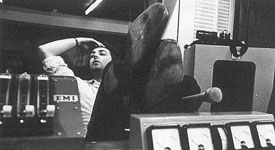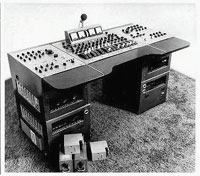Debugging a Beatles Console
 Of all the technical problems that beset sound studios, ground noise and RF problems are surely responsible for the most lost billings, ripped up control rooms, and prematurely gray hair. A compendium of ground noise analysis would fill a small room, and this Scrapbook area is for stories, not dissertation. But before proceeding, I want to make two quick points:
Of all the technical problems that beset sound studios, ground noise and RF problems are surely responsible for the most lost billings, ripped up control rooms, and prematurely gray hair. A compendium of ground noise analysis would fill a small room, and this Scrapbook area is for stories, not dissertation. But before proceeding, I want to make two quick points:
- 99% of ground noise issues can be prevented or fixed with correct cabling and termination.
- As the folks as Jensen Transformers say, “The sump theory doesn’t work”. Burying giant ground rods in the soil and/or running fat welding cables under the floor is not the way to go.
All right, now let’s spin this yarn.
Beautiful Downtown Hoboken
 Years ago, I got a call from the folks at Waterfront Studios in Hoboken, New Jersey, a home base for Lenny Kravitz. Lenny purchased the “Redd 37 Stereosonic” consoles that the Beatles had used at EMI (Electrical & Musical Industries). EMI’s “Record Engineering Development Division” built Redd’s for the EMI studios at Abbey Road and in the Netherlands. He acquired these amazing pieces through Dan Alexander Audio.
Years ago, I got a call from the folks at Waterfront Studios in Hoboken, New Jersey, a home base for Lenny Kravitz. Lenny purchased the “Redd 37 Stereosonic” consoles that the Beatles had used at EMI (Electrical & Musical Industries). EMI’s “Record Engineering Development Division” built Redd’s for the EMI studios at Abbey Road and in the Netherlands. He acquired these amazing pieces through Dan Alexander Audio.
Everybody loved the sound of the Redd 37 and Lenny had already recorded some tracks on it, but there was a stubborn RF problem. Audio from a nearby FM transmitter was leaking into the output busses, and it was driving them nuts. Waterfront had a couple of New York area techs look at the problem, then I got a call. I told the owners I could fix it, packed some test gear along with an assortment grounding and RF parts, and flew out.
Henry Hirsch picked me up at Newark Airport, and we headed towards the studio. Hoboken has been the butt of some jokes, but it’s a cool old town, just across the water from the West Side Highway. Sinatra grew up there. Hoboken’s got plenty of atmosphere, and great views of the Hudson River and the City.
Meet The Beatles’ console
 We pulled up to the studio and the guys showed me around. Just inside the control room door there it was, looking like something out of a submarine. With its big black knobs and oversize VU meters, the Redd 37 was amazing to behold. Standing in front of it, you just couldn’t resist sliding the big gearshift style faders back and forth, and clicking the hefty rotary switches a couple of times. It had eight mic inputs, four aux inputs, four buss outputs, and a four track monitor section. As I recall, the “valve” mic and line amps were made by Siemens in Germany. The engineer could plug in lunchbox size “Pop” or “Classical” EQ modules.
We pulled up to the studio and the guys showed me around. Just inside the control room door there it was, looking like something out of a submarine. With its big black knobs and oversize VU meters, the Redd 37 was amazing to behold. Standing in front of it, you just couldn’t resist sliding the big gearshift style faders back and forth, and clicking the hefty rotary switches a couple of times. It had eight mic inputs, four aux inputs, four buss outputs, and a four track monitor section. As I recall, the “valve” mic and line amps were made by Siemens in Germany. The engineer could plug in lunchbox size “Pop” or “Classical” EQ modules.
It was easy to imagine Paul or George hunched over the Redd with a cigarette, working out a chorus or last minute lyric change. But I was there to work, not daydream. We switched on the console and they showed me the problem. After bringing a few faders up and figuring out how to route audio through the monitor section we brought up the volume pot and there it was, that filtered high frequency “chica chica chiaca” sound, the top end of some tune the station was playing. RF energy was finding its way into the Redd, and being “detected” (converted to audio) by something in the console’s electronics.
The historical importance of the Redd imposed a condition that was unspoken but obvious. The Redd simply could not be modified or altered in any way. With any other console, a minor circuitry change would not raise eyebrows. But in this case, it would be out of the question. If some component in the Redd has failed I would replace it – preferably with the exact same part, which we would somehow locate. But modify a Beatles console? No way. It worked in London, and it would work in New Jersey.
With many grounding and RF problems, the best opening strategy is to totally disconnect the suspect equipment from the “outside world”. In most cases, this will tell you whether the problem is with the equipment under test, or elsewhere. While listening to the problem (or watching it on a ‘scope), you unplug every cable that you possibly can. In nearly all cases, the problem will go away (see point #1, above.) You then start plugging things back in, while listening carefully. Any cable that doesn’t cause a problem stays, anything that adds noise does not. At the end, one or more “problem children” will be lying on the floor. That’s when the real fun starts. (And where I end my tutorial and return to the story, because correcting the problem children can get very tricky.)
In this case, it was the mic and echo send cables. With all of them disconnected, the Redd was quiet. But with one or more plugged in, it was RF city. The solution? Ferrite beads, and maybe RF “chokes”. But not inside the console.
I built a short version of a “mic cable”, with the two signal wires at the male end wrapped around ferrite beads. The female end of my little adaptor plugged into the real mic, and the male side plugged into the Redd. Voila, no RF. The echo sends were a little more stubborn. (It may seem odd that noise could enter a mixer though one of its outputs, but actually this is quite common.) In any case, little filter chokes did the trick, so I built similar adaptor cables for each of the echo sends. That was it! Problem solved.
The moral: sometimes with a little creative thinking, the most imtimidating technical problems can be cured painlessly. In some cases, before lunch time!
All photos by Richard Alexander. Many thanks to Dan Alexander Audio for letting us include them.
